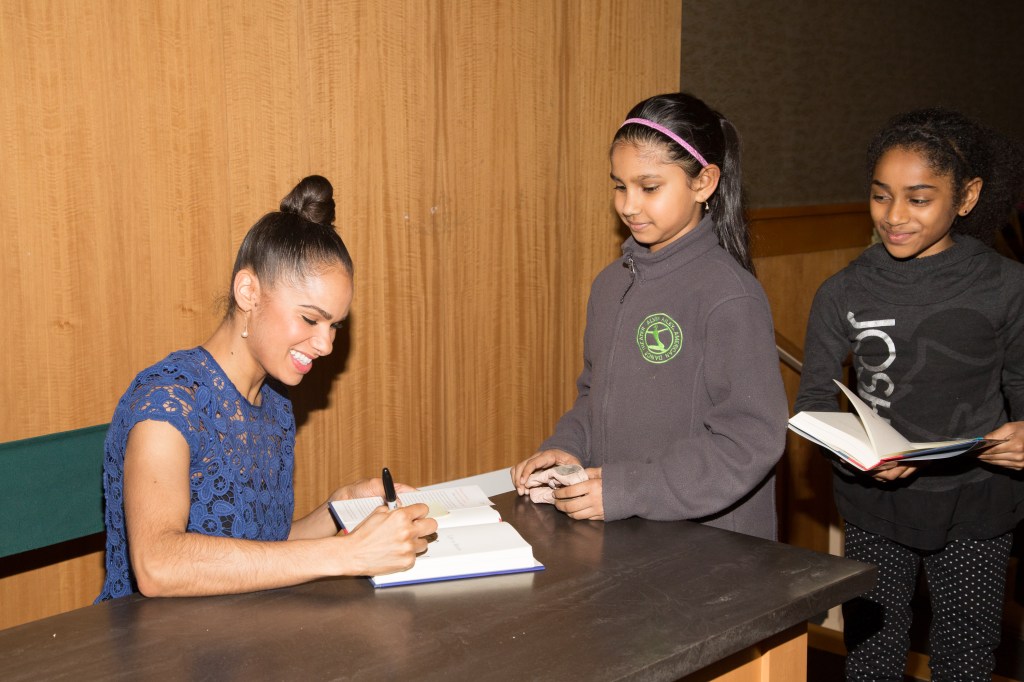TheGrio Awards, Trailblazer Icon: Misty Copeland
The ballerina reminds us that her grace goes beyond center stage and inhabits all spaces as she pushes for greater diversity and inclusion in ballet.
Misty Copeland cemented her place in dance history after becoming the first Black ballerina promoted to principal dancer for the prestigious American Ballet Theatre in 2015 – a feat that had not been accomplished in the history of ABT, founded in 1939.
Since then, Copeland, 41, has trailblazed throughout the creative space as a New York Times bestselling author, charitable nonprofit organizer for the Misty Copeland Foundation and advocate for greater diversity in the arts for current and future generations of dancers.
This year, she is being honored with the Trailblazer Icon Award at “Byron Allen Presents theGrio Awards,” a celebration produced by Byron Allen, founder/chairman/CEO of Allen Media Group, which owns theGrio.
Copeland has not shied away from the spotlight since captivating America with her powerful leaps and dynamic performances at center stage. She became a household name over the years, transcending a dance culture that has a dark side of perpetuating perfectionism, unhealthy body image standards and racism. Copeland has performed with the late superstar Prince, starred in viral campaigns with brands such as Under Armour and Coach, and sat down for an intimate conversation with former President Barack Obama.

Her most recent groundbreaking project is a short film,”Flower,” which premiered in June at the Tribeca Film Festival. This is the first film independently produced under Copeland’s production company, Life in Motion, which she co-founded with dancer-turned-producer Leyla Fayyaz, a longtime friend from ABT.
The 28-minute silent film explores the Bay Area’s housing affordability crisis through its main character, Rose (played by Copeland). Rose is a dance teacher and waitress struggling with keeping her home and caring for her mother, who has dementia. At the same time, she sees how gentrification is causing her neighborhood to rapidly disappear. The film features the first dance scenes from Copeland since she took a three-year break from performing.
“To have that experience within this new experience of being a producer and in this type of film, it felt good,” Copeland said. “Now, stepping back and watching it, I feel like there are so many layers to my intentions, but also what I was feeling in those moments.”
As Copeland resurges into the spotlight, the multi-hyphenate proves that her steady ascension involves empowering others and lifting her community as she climbs.
While she has dedicated most of her career to cultivating more diverse dance spaces across various realms, the lack of Black representation throughout her upbringing in the ballet community inspires her to push the industry in a direction that celebrates dancers of all shades.
Her dedication to more Black and brown representation in the dance universe led the performer to create a petition for more inclusiveness in the digital space. The petition aims to add more skin tones of the ballet slipper emoji. The request garnered over 22,000 signatures since Copeland called out Apple and the Unicode Consortium, an organization responsible for creating and regulating symbols, in September.
“…These may seem like small, insignificant things to a lot of people, but there’s a much bigger meaning and deeper meaning behind it,” Copeland told the Associated Press.
“You know, going back to the history of the pink tight and the pink ballet slipper — yes, there were white European people doing it in that time, so they made these things to reflect them in their skin color. But now that’s not all who’s dancing and who’s being exposed to it. So we should see that representation through and through,” she continued.
Despite the adversities she faced in her early years, Copeland is a walking testimony of living in alignment with life’s purpose.

In her highly acclaimed memoir, “Life in Motion,” the Los Angeles native shared how her beginnings in ballet did not follow the traditional route. In fact, she started late. Training to become a professional ballet dancer can begin as early as 3 years old.
Copeland started at 13.
In hindsight, her late bloom into this classical artistry was an advantage. The unfamiliar territory limited her expectations as she entered practice, surrounded by prodigies at her local Boys & Girls Club.
“I never saw it as pressure, I think because I was so naive about the ballet world,” Copeland said in a 2022 Harvard Business Review interview. “My family was, too. We were all new to it. But once I was introduced, I thought, ‘there’s no way I can go on without having this in my life.'”
As one of five siblings, her older sister Erica served as a catalyst to help the soon-to-be ballerina break out of her shyness. Before stepping into a ballet studio, Copeland followed her sister and auditioned for her middle school’s drill team. After getting a callback from the team’s coach, she learned she would join the squad and serve as team captain of 60 members.
Little did Copeland know that her participation on the drill team allowed her coach to see talent that extended beyond the amateur choreography for pep rallies and football games. Her coach, who had trained in classical dance, encouraged Copeland to attend ballet classes at the recreation center.
That set Copeland on a trailblazing path.
Copeland became the first Black woman to perform the lead role of “Odette/Odile” in ABT’s “Swan Lake” in 2014. She was inducted into the Boys & Girls Club National Hall of Fame in 2012 and received the Breakthrough Award from the Council of Urban Professionals that same year. Her honors include being named the National Youth of the Year Ambassador for the Boys & Girls Club of America and accepting the Young, Gifted & Black Award at the 2013 Black Girls Rock ceremony.
Copeland’s extraordinary talent sets her apart. However, navigating a cutthroat industry where she was placed at the forefront as “the only” Black ballerina was a heavy weight she carried.
Mentors made the load lighter because she learned to handle situations and conversations with her counterparts.
“You don’t want to go in there angry or upset, because then you’re the ‘angry Black woman,'” Copeland said in an interview last year. “You don’t want to cry because they’ll see you as weak or overly emotional. Still, I was very up-front and clear about what I was going through, and I never hid the fact that these things were connected to my race,” she continued.
Diversifying the ballet and dance world remains a priority for Copeland. She acknowledged her efforts would not be possible without the women who lifted her up and carved a path for her to be successful.

In her newest memoir, “The Wind at My Back,” Copeland honors one of those mentors, Raven Wilkinson, who in 1955 became the first Black ballerina to receive a contract with a major ballet company. She highlights Wilkinson’s contributions as one of the only Black ballerinas in the 1950s and ’60s and chronicles the gruesome adversities she faced in that era. Copeland explores her close friendship with Wilkinson, who died in 2018, and their connection to an art form that both have dedicated to improving for the next generation of Black and brown ballerinas.
Copeland plans more time onstage after taking a performance hiatus due to the coronavirus pandemic and the birth of her son in 2022. Her transition to the big screen will continue with more film projects, and her short film “Flower” converting into a series. As Copeland expands her production company, her platform will be used to tell untold stories of women of color.
Copeland’s unwavering devotion to advancing ballet culture and uplifting her community is a never-ending dance she has performed her entire career. Her outreach and accomplishments have no bounds as she reaches new heights.
TheGrio is FREE on your TV via Apple TV, Amazon Fire, Roku and Android TV. Also, please download theGrio mobile apps today!

